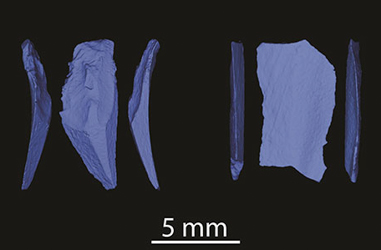Oldest traces of man found in Austria

Archaeologists in Austria have found the oldest traces of modern humans in Europe, dating back to 43,500 years ago.
The archaeologists had been digging at the Willendorf II site in the Wachau region of Lower Austria from 2006 to 2011, where they found small stone artefacts believed to have been used as parts of weapons for hunting, typical of the Upper Paleolithic Age, that they were then able to date as being 43,500 years old.
The team was able to reconstruct the climate and vegetation of the region at the time through soil analysis, as well as through the composition of the shells of different species and sub-species of snails buried in that particular layer of soil.
They said this method of climate reconstruction is much more accurate than carbon-14 datings commonly associated with climate data from the Paleolithic Age.

3-D image of two of the stone artefacts. Photo: Philip Nigst
Philip Nigst from the Division of Archaeology at the University of Cambridge told the Austrian Press Agency that this showed the first modern humans settled in the region at the beginning of a warm phase of the Ice Age, where the region was a tundra steppe with light coniferous forests.
This places the existence of modern humans in Europe several thousands of years earlier than previously thought. Bence Viola from the Department of Anthropology at the University of Vienna told the Austrian Press Agency this also showed the period of time that modern humans shared with Neanderthals is greater, now estimated to have been at least 3,500 years.
"We know that they mixed, because all humans outside of Africa today carry 1.5 to 3 percent Neanderthal DNA," she said.
The Paleolithic site at Willendorf is well known for the Venus of Willendorf, a small limestone figurine of a female figure estimated to have been made between about 28,000 and 25,000 BC, which was found in 1908 and can now be seen in Vienna's Natural History museum.
Comments
See Also
The archaeologists had been digging at the Willendorf II site in the Wachau region of Lower Austria from 2006 to 2011, where they found small stone artefacts believed to have been used as parts of weapons for hunting, typical of the Upper Paleolithic Age, that they were then able to date as being 43,500 years old.
The team was able to reconstruct the climate and vegetation of the region at the time through soil analysis, as well as through the composition of the shells of different species and sub-species of snails buried in that particular layer of soil.
They said this method of climate reconstruction is much more accurate than carbon-14 datings commonly associated with climate data from the Paleolithic Age.

3-D image of two of the stone artefacts. Photo: Philip Nigst
Philip Nigst from the Division of Archaeology at the University of Cambridge told the Austrian Press Agency that this showed the first modern humans settled in the region at the beginning of a warm phase of the Ice Age, where the region was a tundra steppe with light coniferous forests.
This places the existence of modern humans in Europe several thousands of years earlier than previously thought. Bence Viola from the Department of Anthropology at the University of Vienna told the Austrian Press Agency this also showed the period of time that modern humans shared with Neanderthals is greater, now estimated to have been at least 3,500 years.
"We know that they mixed, because all humans outside of Africa today carry 1.5 to 3 percent Neanderthal DNA," she said.
The Paleolithic site at Willendorf is well known for the Venus of Willendorf, a small limestone figurine of a female figure estimated to have been made between about 28,000 and 25,000 BC, which was found in 1908 and can now be seen in Vienna's Natural History museum.
Join the conversation in our comments section below. Share your own views and experience and if you have a question or suggestion for our journalists then email us at [email protected].
Please keep comments civil, constructive and on topic – and make sure to read our terms of use before getting involved.
Please log in here to leave a comment.